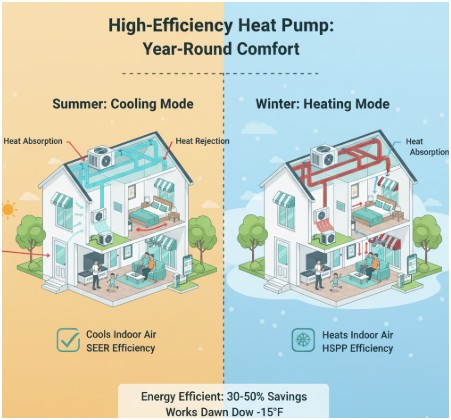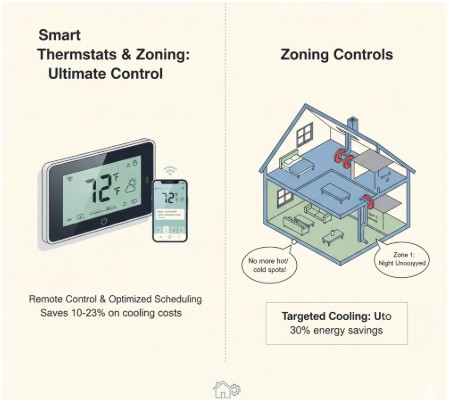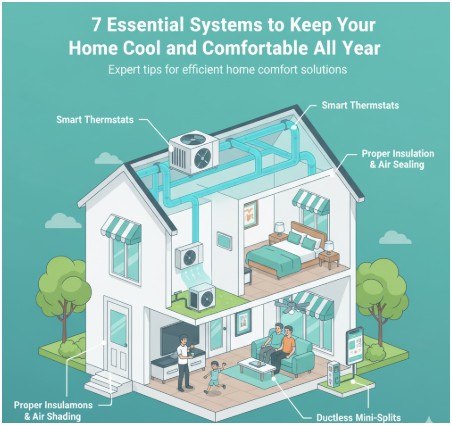Maintaining optimal indoor temperatures throughout the year requires more than just cranking up the air conditioning during summer months.
A well-planned approach to home cooling involves multiple systems working together to create a comfortable, energy-efficient environment regardless of outside weather conditions.
Whether you’re dealing with scorching summers or looking for ways to maintain consistent comfort levels, implementing the right combination of cooling solutions can transform your living space while potentially reducing energy costs.
7 Essential Home Cooling Systems for Year-Round Comfort
Central Air Conditioning Systems
Central air conditioning remains the gold standard for whole-home cooling, providing consistent temperature control across multiple rooms and floors.
These systems work by distributing cooled air through a network of ducts, ensuring every corner of your home receives adequate cooling.
Modern central AC units feature variable-speed technology that adjusts output based on actual cooling needs, resulting in energy savings of up to 40% compared to older single-speed models.
When considering central air, proper sizing is crucial for optimal performance. An oversized unit will cycle on and off frequently, leading to poor humidity control and higher energy bills.
Conversely, an undersized system will struggle to maintain comfortable temperatures during peak demand periods.
Professional air conditioning installation in Cottonwood Heights ensures proper sizing calculations based on your home’s square footage, insulation levels, and local climate conditions.
High-Efficiency Heat Pumps

Heat pumps offer year-round comfort by providing both heating and cooling capabilities in a single system. During summer months, they function like traditional air conditioners, extracting heat from indoor air and transferring it outside.
In winter, the process reverses, pulling heat from outdoor air even in cold temperatures. Modern heat pumps can operate efficiently in temperatures as low as -15°F, making them suitable for most climates.
The efficiency of heat pumps is measured by their Seasonal Energy Efficiency Ratio (SEER) for cooling and Heating Seasonal Performance Factor (HSPF) for heating.
High-efficiency models with SEER ratings of 20+ and HSPF ratings above 10 can reduce energy consumption by 30-50% compared to conventional systems.
Additionally, many heat pumps qualify for federal tax credits and local utility rebates, helping offset initial installation costs.
Ductless Mini-Split Systems
Ductless mini-split systems provide targeted cooling for specific areas without requiring extensive ductwork modifications.
These systems consist of an outdoor compressor unit connected to one or more indoor air handlers via refrigerant lines.
Each indoor unit can be controlled independently, allowing for customized temperature zones throughout your home.
Mini-splits excel in homes with additions, converted spaces, or areas where traditional ductwork isn’t feasible.
They’re also ideal for improving comfort in rooms that consistently run warmer or cooler than the rest of the house.
With SEER ratings often exceeding 25, these systems deliver exceptional energy efficiency while providing whisper-quiet operation.
Smart Thermostats and Zoning Controls

Smart thermostats revolutionize home comfort by learning your preferences and automatically adjusting temperatures based on occupancy patterns, weather forecasts, and energy rates.
These devices can reduce cooling costs by 10-23% through optimized scheduling and remote control capabilities that prevent unnecessary cooling of unoccupied homes.
Advanced zoning systems take temperature control a step further by dividing your home into separate zones, each with its own independent temperature settings.
Motorized dampers in the ductwork open and close based on individual zone requirements, directing cooled air only where needed.
This targeted approach can reduce energy consumption by up to 30% while eliminating hot and cold spots throughout your home.
Proper Insulation and Air Sealing
Effective insulation and air sealing form the foundation of any efficient cooling system.
Without proper thermal barriers, your cooling equipment works harder to maintain comfortable temperatures, leading to higher energy bills and reduced system lifespan.
Key areas requiring attention include attics, basements, crawl spaces, and areas around windows and doors.
Modern insulation materials like spray foam and high-performance fiberglass can significantly improve your home’s thermal envelope.
Air sealing techniques, including caulking gaps and weatherstripping doors and windows, prevent conditioned air from escaping while keeping hot outdoor air from infiltrating your living spaces.
These improvements can reduce cooling loads by 20-30%, enabling the use of smaller, more efficient equipment.
Ceiling Fans and Ventilation Strategies
Ceiling fans create air movement that makes occupants feel 3-4°F cooler, allowing you to raise thermostat settings while maintaining comfort levels.
Energy Star-certified ceiling fans use up to 60% less energy than conventional models while providing superior air circulation.
Strategic placement in bedrooms, living areas, and outdoor spaces extends comfort zones throughout your property.
Whole-house ventilation strategies, including exhaust fans in bathrooms and kitchens, prevent humidity buildup that makes indoor spaces feel warmer than actual temperatures.
Heat recovery ventilators (HRVs) and energy recovery ventilators (ERVs) provide fresh air circulation while minimizing energy losses, maintaining indoor air quality without compromising cooling efficiency.
Window Treatments and Exterior Shading
Solar heat gain through windows can account for 25-30% of cooling loads in typical homes. Strategic window treatments and exterior shading significantly reduce this burden while maintaining natural light and views.
Low-E window films reflect infrared radiation while allowing visible light to pass through, reducing cooling costs by 5-15% without permanent modifications.
Exterior shading solutions like awnings, pergolas, and strategically planted trees provide superior heat rejection compared to interior treatments.
South and west-facing windows benefit most from shading, as they receive the most intense solar radiation during peak cooling hours.
Automated exterior shutters and adjustable louvers offer dynamic shading that adapts to changing sun angles throughout the day.
Ready to upgrade your home’s cooling system? Contact qualified HVAC system professionals to assess your current setup and recommend the most effective combination of systems for your specific needs and budget.
A comprehensive cooling strategy tailored to your home’s unique characteristics ensures optimal comfort and efficiency for years to come.




